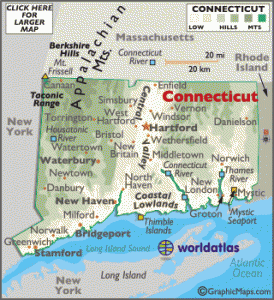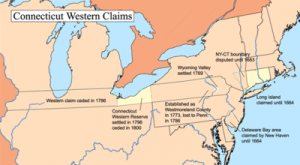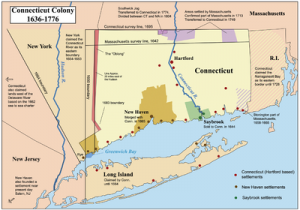Connecticut

Connecticut’s State Capitol: Home to History
State Senator L. Scott Frantz (R-Greenwich) hosts a ten minute tour of Connecticut’s historic State Capitol Building located atop Hartford’s Bushnell Park.
Timeline of Connecticut: 1600’s:
- (1614) Dutch trader, Adriaen Block, sailed up Connecticut River, landed near Hartford
- (1633) Dutch purchased land from Pequot Tribe, made permanent settlement; Plymouth Colony sent William Holmes to establish trading post at Windsor
- (1634) Weatherford founded, oldest permanent setttlement in state
- (1635) First English settlers arrived in Windsor; Fort erected at Saybrook
- (1636) Massachusetts colonists arrived, founded Hartford
- (1637) War between settlers and Pequot Indians; Capt. John Mason led colonists to victory
- (1638) New Haven founded
- (1639) First constitution, the Fundamental Orders of Connecticut, adopted; John Haynes chosen as first Governor
- (1643) Connecticut joined in formation of New England Confederation
- (1650) Legislature adopted Code of Laws
- (1662) Governor Winthrop received royal charter for Connecticut Colony from King Charles II
- (1675-1676) Connecticut participated in King Philip’s War; Indians were massacred
- (1687) King James revoked charter, took colonists’ legal rights; Charter Oak incident occurred
- (1689) Connecticut government resumed under charter
1700’s
- (1701) Collegiate School authorized
- (1717) Collegiate School moved to New Haven, changed name to Yale
- (1740) Tinware manufactured at Berlin; religious “Great Awakening” occurred
- (1745) Connecticut troops led by Roger Wolcott captured Louisburg
- (1765) English Parliament passed Stamp Act
- (1767) English Parliament passed Townshead Act
- (1774) Connecticut extended jurisdiction over Susquehanna Company in northern Pennsylvania; Connecticut sent representatives to First Continental Congress meeting in Philadelphia
- (1775) Connecticut men helped seize Ft. Ticonderoga; first gun powder mill started in East Hartford; militiamen from Connecticut left for Massachusetts for “Lexington Alarm”
- (1776) Declaration of Independence signed; Nathan Hale captured by British
- (1777) British troops raided Danbury
- (1779) British troops raided New Haven, Fairfield, Norwalk
- (1781) Benedict Arnold, British forced captured Fort Griswold, burned many buildings; one major Revolutionary War battled occurred at New London
- (1783) Protestant Episcopal Church formed at Woodbury
- (1784) Connecticut relinquished Westmoreland area to Pennsylvania; act passed for emancipation at age of twenty-five for all Negroes
- (1787) At Philadelphia Constitutional Convention, the Connecticut Comprise enacted allowing equal representation in Congress, House of Representatives by population
- (1788) Federal Constitution approved; Connecticut became Nation’s fifth state
- (1792) First turnpike established from New London to Norwich
- (1795) Connecticut Western Reserve lands sold for $1,200,000, proceeds used to establish School Fund
- 1800:
- (1802) Brass industry began at Waterbury
- (1806) Noah Webster published first edition of his dictionary
- (1814) Hartford Convention held at Old State House
- (1815) First steamboat on Connecticut River to Hartford
- (1817) Reformers defeated Federalists in politicial revolution; school for deaf founded in Hartford
- (1818) New Constitution adopted; ended system of established church
- (1820) Capt. Nathaniel Palmer, Stonington, discovered continent of Antarctica
- (1822) Capt. John Davis, New Haven, first to set foot in Antarctica
- (1828) Farmington Canal opened from New Haven to Farmington
- (1832) First Connecticut railroad incorporated
- (1835) Colt patented revolver
- (1838) Railroad completed between New Haven and Hartford
- (1843) Charles Goodyear developed rubber vulcanizing process
- (1844) Dr. Horace Wells used anesthesia at Hartford
- (1848) Slavery abolished in Connecticut
- (1858) Charter Oak Tree felled during storm
- (1861 – 1865) 57,379 men, women volunteer for Civil War; more than 20,000 killed
- (1868) Land at Groton given to U. S. Navy for naval station
- (1875) Hartford became capital city
- (1877) First telephone exchange in world opened in New Haven
- (1897) Pope Manufacturing Co. began automobile manufacturing
Map showing the Connecticut, New Haven, and Saybrook colonies and the CT-NY dispute
The U.S. state of Connecticut began as three distinct settlements, referred to at the time as “Colonies” or “Plantations”. These ventures were eventually combined under a single royal charter in 1662.
Colonies in Connecticut – Main articles: New Netherland, Saybrook Colony, New Haven Colony, and Connecticut Colony
Various Algonquian tribes inhabited the area prior to European settlement. The Dutch were the first Europeans in Connecticut. In 1614 Adriaen Block explored the coast of Long Island Sound, and sailed up the Connecticut River at least as far as the confluence of the Park River, site of modern Hartford, Connecticut. By 1623, the new Dutch West India Company regularly traded for furs there and ten years later they fortified it for protection from the Pequot Indians as well as from the expanding English colonies. They fortified the site, which was named “House of Hope” (also identified as “Fort Hoop“, “Good Hope” and “Hope”), but encroaching English colonists made them agree to withdraw in the 1650 Treaty of Hartford, and by 1654 they were gone.
The first English colonists came from the Bay Colony and Plymouth Colony in Massachusetts. They settled at Windsor in 1633,Wethersfield in 1634, and Hartford in 1636. Thomas Hooker led the Hartford group.
In 1631, the Earl of Warwick granted a patent to a company of investors headed by William Fiennes, 1st Viscount Saye and Sele andRobert Greville, 2nd Baron Brooke. They funded the establishment of the Saybrook Colony (named for the two lords) at the mouth of the Connecticut River, where Fort Saybrook, was erected in 1636. Another Puritan group left Massachusetts and started the New Haven Colony farther west on the northern shore of Long Island Sound in 1637. The Massachusetts colonies did not seek to govern their progeny in Connecticut and Rhode Island. Communication and travel were too difficult, and it was also convenient to have a place for nonconformists to go.
The English settlement and trading post at Windsor especially threatened the Dutch trade, since it was upriver and more accessible to Native people from the interior. That fall and winter the Dutch sent a party upriver as far as modern Springfield, Massachusetts spreading gifts to convince the indigenous inhabitants in the area to bring their trade to the Dutch post at Hartford. Unfortunately, they also spread smallpox and, by the end of the 1633–34 winter, the Native population of the entire valley was reduced from over 8,000 to less than 2,000. Europeans took advantage of this decimation by further settling the fertile valley.
The Pequot War
 Pequot War engraving from Library of Congress – Main article: Pequot War
Pequot War engraving from Library of Congress – Main article: Pequot War
The Pequot War was the first serious armed conflict between the indigenous peoples and the European settlers in New England. The ravages of disease, coupled with trade pressures, invited the Pequots to tighten their hold on the river tribes. Additional incidents began to involve the colonists in the area in 1635, and next spring their raid on Wethersfield prompted the three towns to meet. Following the raid on Wethersfield, the war climaxed when 300 Pequot men, women, and children were burned out of their village, hunted down and massacred.
On May 1, 1637, leaders of Connecticut Colony’s river towns each sent delegates to the first General Court held at the meeting house in Hartford. This was the start of self-government in Connecticut. They pooled their militia under the command of John Mason of Windsor, and declared war on the Pequots. When the war was over, the Pequots had been destroyed as a tribe. In the Treaty of Hartford in 1638, the various New England colonies and their Native allies divided the lands of the Pequots amongst themselves.
Under the Fundamental Orders – Main articles: Fundamental Orders of Connecticut and Connecticut Colony
The River Towns had created a general government when faced with the demands of a war. In 1639, they took the unprecedented step of documenting the source and form of that government. They enumerated individual rights and concluded that a free people were the only source of government’s authority. Rapid growth and expansion grew under this new regime.
On April 22, 1662, the Connecticut Colony succeeded in gaining a Royal Charter that embodied and confirmed the self-government that they had created with the Fundamental Orders. The only significant change was that it called for a single Connecticut government with a southern limit at Long Island Sound, and a western limit of the Pacific ocean, which meant that this charter was still in conflict with the New Netherland colony.
Since 1638, the New Haven Colony had been independent of the river towns, but there other factors added to the Charter. New Haven Colony lost its strongest governor, Theophilus Eaton, and suffered economically after losing its only ocean going ship. Furthermore, in the early 1660s the colony harbored several of the regicide judges who had sentenced King Charles I to death. The colony was absorbed by the Connecticut Colony partly as royal punishment by King Charles II for harboring the regicide judges. When the English took New Netherland in the 1660s the new government of the Province of New York claimed the New Haven settlements on Long Island. By January 1665, the merger of the two colonies was completed.
Indian pressures were relieved for some time by the severity and ferocity of the Pequot War. King Philip’s War (1675–1676) brought renewed fighting to Connecticut. Although primarily a war affecting Massachusetts, Connecticut provided men and supplies. This war effectively removed any remaining warlike Native American influences in Connecticut.
The Dominion of New England
In 1686, Sir Edmund Andros was commissioned as the Royal Governor of the Dominion of New England. Andros maintained that his commission superseded Connecticut’s 1662 charter. At first, Connecticut ignored this situation. But in late October 1687, Andros arrived with troops and naval support. Governor Robert Treat had no choice but to convene the assembly. Andros met with the governor and General Court on the evening of October 31, 1687.
Governor Andros praised their industry and government, but after he read them his commission, he demanded their charter. As they placed it on the table, people blew out all the candles. When the light was restored, the charter was missing. According to legend, it was hidden in the Charter Oak. Sir Edmund named four members to his Council for the Government of New England and proceeded to his capital at Boston.
Since Andros viewed New York and Massachusetts as the important parts of his Dominion, he mostly ignored Connecticut. Aside from some taxes demanded and sent to Boston, Connecticut also mostly ignored the new government. When word arrived that the Glorious Revolution had placed William and Mary on the throne, the citizens of Boston arrested Androsand sent him back to England in chains. The Connecticut court met and voted on May 9, 1689 to restore the old charter. They also reelected Robert Treat as governor each year until 1698.
Territorial disputes
According to the 1650 Treaty of Hartford with the Dutch, the western boundary of Connecticut ran north from the west side of Greenwich Bay “provided the said line come not within 10 miles (16 km) of Hudson River.” On the other hand, Connecticut’s original charter in 1662 granted it all the land to the “South Sea” (i.e. the Pacific Ocean).
- ALL that parte of our dominions in Newe England in America bounded on the East by Norrogancett River, commonly called Norrogancett Bay, where the said River falleth into the Sea, and on the North by the lyne of the Massachusetts Plantacon, and on the south by the Sea, and in longitude as the lyne of the Massachusetts Colony, runinge from East to West, (that is to say) from the Said Norrogancett Bay on the East to the South Sea on the West parte, with the Islands thervnto adioyneinge, Together with all firme lands … TO HAVE AND TO HOLD … for ever….
Dispute with New York – Main article: Border Disputes Between New York and Connecticut
Needless to say, this brought it into territorial conflict with those states which then lay between Connecticut and the Pacific. A patent issued on March 12, 1664, granted theDuke of York “all the land from the west side of Connecticut River to the east side of Delaware Bay.” In October, 1664, Connecticut and New York agreed to grantLong Island to New York, and establish the boundary between Connecticut and New York as a line from theMamaroneck River “north-northwest to the line of the Massachusetts”, crossing the Hudson River near Peekskilland the boundary of Massachusetts near the northwest corner of the current Ulster County, New York. This agreement was never really accepted, however, and boundary disputes continued. The Governor of New York issued arrest warrants for residents of Greenwich, Rye, and Stamford, and founded a settlement north of Tarrytown in what Connecticut considered part of its territory in May 1682. Finally, on November 28, 1683, the states negotiated a new agreement establishing the border as 20 miles (32 km) east of the Hudson River, north to Massachusetts. In recognition of the wishes of the residents, the 61,660 acres (249.5 km2) east of the Byram River making up the Connecticut Panhandle were granted to Connecticut. In exchange, Rye was granted to New York, along with a 1.81-mile (2.91 km) wide strip of land running north from Ridgefield to Massachusetts alongside Dutchess, Putnam, and Westchester Counties, New York, known as the “Oblong”.
Dispute with Pennsylvania
 A map showing Connecticut’s western land claims.
A map showing Connecticut’s western land claims.
In the 1750s, the western frontier remained on the other side of New York. In 1754 the Susquehannah Company of Windham, Connecticut obtained from a group of Native Americans a deed to a tract of land along the Susquehanna River which covered about one-third of present-day Pennsylvania. This venture met with the disapproval of not only Pennsylvania, but also of many in Connecticut including the Deputy Governor, who opposed Governor Jonathan Trumbull‘s support for the company, fearing that pressing these claims would endanger the charter of the colony. In 1769, Wilkes-Barre was founded by John Durkeeand a group of 240 Connecticut settlers. The British government finally ruled “that no Connecticut settlements could be made until the royal pleasure was known”. In 1773 the issue was settled in favor of Connecticut and Westmoreland, Connecticut was established as a town and later a county.
Pennsylvania did not accede to the ruling, however, and open warfare broke out between them and Connecticut, ending with an attack in July 1778, which killed approximately 150 of the settlers and forced thousands to flee. While they periodically attempted to regain their land, they were continuously repulsed, until, in December 1783, a commission ruled in favor of Pennsylvania. After complex litigation, in 1786, Connecticut dropped its claims by a deed of cession to Congress, in exchange for freedom for war debt and confirmation of the rights to land further west in present-day Ohio, which became known as the Western Reserve. Pennsylvania granted the individual settlers from Connecticut the titles to their land claims. Although the region had been called Westmoreland County, Connecticut, it has no relationship with the current Westmoreland County, Pennsylvania.
The Western Reserve, which Connecticut received in recompense for giving up all claims to any Pennsylvania land in 1786, constituted a strip of land in what is currently northeast Ohio, 120 miles (190 km) wide from east to west bordering Lake Erie and Pennsylvania. Connecticut owned this territory until selling it to the Connecticut Land Company in 1795 for $1,200,000, which resold parcels of land to settlers. In 1796, the first settlers, led by Moses Cleaveland, began a community which was to become Cleveland, Ohio; in a short time, the area became known as “New Connecticut”.
An area 25 miles (40 km) wide at the western end of the Western Reserve, set aside by Connecticut in 1792 to compensate those from Danbury, New Haven, Fairfield, Norwalk, and New London who had suffered heavy losses when they were burnt out by fires set by British raids during the War of Independence, became known as the Firelands. By this time, however, most of those granted the relief by the state were either dead or too old to actually move there. The Firelands now constitutes Erie and Huron Counties, as well as part of Ashland County, Ohio.
The American Revolution (1775–1789)
 Governor Jonathan Trumbull
Governor Jonathan Trumbull
Connecticut was the only one of the 13 colonies involved in the American Revolution that did not have an internal revolution of its own. It had been largely self-governing since its beginnings. Governor Jonathan Trumbull was elected every year from 1769 to 1784. Connecticut’s government continued unchanged even after the revolution, until the United States Constitution was adopted in 1789. A Connecticut privateer was the Guilford, formerly the Loyalist privateer Mars.
Several significant events during the American Revolution occurred in Connecticut. Notably, the landing of a British invasion force in Westport, Connecticut which subsequently marched to and burnt the city of Danbury, Connecticut for safeguarding Patriot supplies and was engaged by General David Wooster and General Benedict Arnold on their return in the Battle of Ridgefield in 1777, which would deter future strategic landing attempts by the British for the remainder of the war. The state was also the launching site for a number of raids against Long Island orchestrated by Samuel Holden Parsons and Benjamin Tallmadge, and provided men and material for the war effort, especially to Washington’s army outside New York City. General William Tryon raided the Connecticut coast in July 1779, focusing on New Haven, Norwalk, and Fairfield. The French General the Comte de Rochambeau celebrated the first Catholic Mass in Connecticut at Lebanon in summer 1781 while marching through the state from Rhode Island to rendezvous with General George Washington in Dobbs Ferry, New York. New London and Groton Heights were raided in September 1781 by Connecticut native and turncoat Benedict Arnold.



